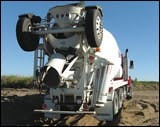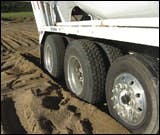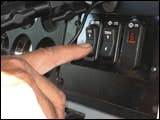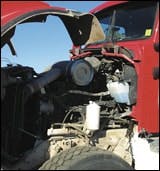Got sand? They do in east-central Minnesota, where glacial lakes and rivers many thousands of years ago deposited silt that's now deep and plentiful. The sand is both useful, as an ingredient in concrete, and an impediment, as it's tough for mixer trucks to traverse work sites.
Off-road enthusiasts who frequent sand dunes know that bleeding air from a vehicle's tires lets them almost float over the soft ground instead of bogging down in their own ruts. When the four-wheeler returns to hard roads, its driver has to pull out hoses to pump the tires back up. But on-board systems available on many heavy vocational trucks do it quickly and conveniently.
The U.S. Army first applied this idea to a few of its amphibious trucks in World War II. By the start of the Gulf War in '91, it had Eaton Corp.'s Central Tire Inflation systems on thousands of tactical cargo trucks, and they worked well, and still do in military operations in Iraq and Afghanistan.
Dana Corp.'s Commercial Vehicle Systems Div., which acquired the product from Eaton several years ago, continues business with the military as well as with commercial customers who find the Spicer Tire Pressure Control system, its civilian name, useful. Most construction truck operators using TPC are in Florida, but Dana says it's finding converts elsewhere, including Minnesota.
Apple Valley Ready Mix, which operates as AVR Inc. out of its namesake suburb south of Minneapolis, runs 140 Kenworth mixer trucks with TPC and is acquiring another 20 now. They're replacing older 6×6s, which had been the only way to place concrete at new jobsites in sandy soil.
"It's amazing what they will go through," said Paul Chaves, AVR's transportation manager, in describing the TPC-equipped trucks. The fleet first tried the system in '03, after managers saw it displayed at a trade show. Herelated that on the first TPC truck's maiden run, it pulled a stuck 6×6 off a site. Customers have noticed how well the trucks get around, and some request deliveries in "the tire trucks," as they call them.
Tire Pressure Control is not a cheap option, costing $8,000 to $16,000, depending on the truck manufacturer and its profit goals, as well as what its engineers think is needed for it to work properly, according to Jim Beverly, Dana's chief engineer for TPC who was present during this visit. For instance, at least one builder adds a high-capacity air compressor that others leave optional. Chaves said he specs his trucks with an 18.7-cubic-foot-per-minute pump, which is adequate.
In spite of the price, TPC makes a strong business case for anyone needing extra off-road mobility in soft soil. It costs about $20,000 less than a 6×6 truck, with its transfer case, extra driveline, front-driving axle and jacked-up suspensions. All that iron adds weight, limiting a 6×6's payload to 9 yards of concrete versus a TPC truck's 11 yards, Chaves said. A 6×6 also needs more maintenance, and partly because of that, it sells for less as a used truck than one with TPC. The fleet usually sells a mixer truck after five years of service.
AVR's Kenworths also have Allison RDS six-speed automatic transmissions, which of course are easy to drive, and they cushion the drivelines on and off road. First bought in a group of trucks in '04, the automatics aren't cheap either, but have eliminated repairs to clutches, driveshafts and U-joints, and their associated breakdowns and unscheduled downtime, Chaves said.
Spicer Tire Pressure Control systems have needed little maintenance other than checking the hoses and fittings on new trucks to be sure they're secure. TPC monitors tire pressure on steer and drive axles and keeps them where they should be, so it's not necessary to check those tires in the morning, said veteran driver Larry Olson, whose truck we used for a demonstration. It does take longer to rotate tires, though, because hoses must be disconnected and reconnected before it's all done.
It was time to see what a truck could do, and outside AVR's garage, Olson had his Kenworth warmed up. It's an '06 W900S set up like many others in the fleet, with a 350-hp Cummins ISM, plus two pusher axles and a booster axle among its specifications. He drove it over to a large sandy area nearby as we followed in 4×4 pickups.
I had related to the guys that in the past I'd gotten a couple of similarly equipped trucks stuck. But I had made the mistake of not airing down the tires before venturing off pavement. Also, the trucks were empty, reducing traction on the drive wheels. Well, as an encore, I managed to get Olson's truck bogged down, too, again while its barrel was empty and its tires were hard. The small crowd offered mock cheers.
Olson got back behind the wheel, punched one of the dash-mounted TPC switches into Off-Road mode, and waited a couple of minutes while air bled out of the steer and drive tires. Then he punched the Allison into Reverse and backed out of the ruts I had made. After several passes without getting stuck, he went off to the quarry and got a load of stone in the barrel; it was the equivalent of about 9 yards of concrete.
Ha! Once again, I got the truck stuck, even with soft tires, while trying to drive up a loose, sandy slope. Olson hopped on the steps, reached in and threw the toggles that locked the tandem's interaxle differential and both its axle diffs. Duh, I could've done that. Now, with less wheel spin, I backed up a little, punched Drive and then charged up the slope — hooray — and onto a flat field where sand had been graded for drying.
The Cummins bellowed heartily as it pushed the truck through the pebbly sand, which seemed bottomless and certainly loose enough to make walking difficult. Yet the truck plowed resolutely ahead — and kept plowing as I began making turns. Even though the big duplex steer-axle tires were cut to the right or left, the front end tried to keep going straight. So I turned gradually, in wide arcs, moving the truck forward and back as needed to avoid going into ravines on three sides of this large sand box.
If I had unlocked the tandem, the truck would steer better, Olson said, when I returned to the trail. But I didn't want to do that while underway because I was afraid I'd break something in the differentials, and if I stopped to unlock the diffs I'd get stuck again, wouldn't I? "Maybe," he said, smiling tolerantly like someone who's been doing this since 1967, because he has.
You'd think the strong torque needed to twist the wheels through the grabby sand would cause the softened tires to slip on their rims and go flat, but they don't, he said; modern radials (Bridgestones in this case) are that tough. But sidewall flexing tends to safely eject stones caught between the dualed tires, which is another advantage of the system.
How much pressure do tires lose when TPC bleeds them? The numbers are programmed in to suit the owner and his operation, Dana's Beverly said. Here the steers drop from 100 psi to 70, and the dualed drives go from 100 to 50 when Off-Road is chosen. An LED read-out on the dash next to TPC's two switches showed those levels. An Emergency setting drops the steers to 30 and the drives to 25. From the Off Road levels, it takes the system about five minutes to air the tires back up, Olson said.
If the driver forgets to punch the system into On-Road mode as he leaves a jobsite, TPC will sense when road speeds get above 25 mph and automatically pump up the tires. It has to be told to bleed them, though. Olson said he decides if that's necessary when he arrives at jobsites. He finds it most useful in pouring curbs and sewer basins where streets have not yet been paved and sand is a real obstacle. TPC also lets a truck squeeze through low doors at warehouses and factories because dropping tire pressure lowers the truck by an inch or more.
How about mud? It's not as effective in that, Olson said. Sand is where it shines. Got some of that where you are? Then TPC might work for you, too.









